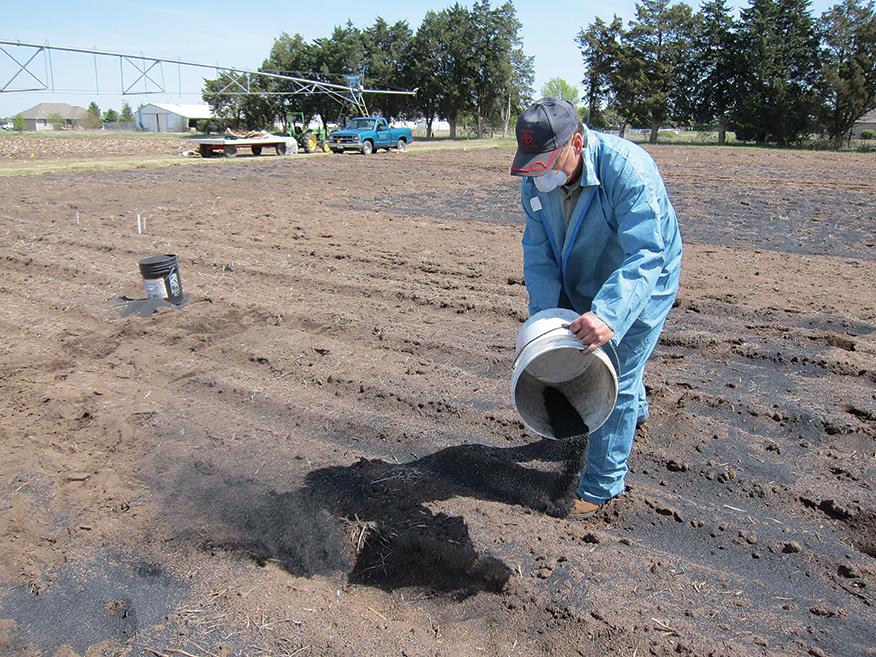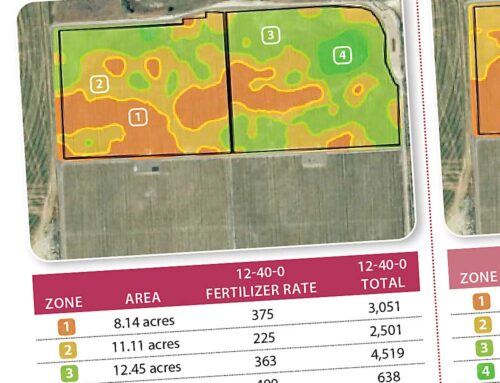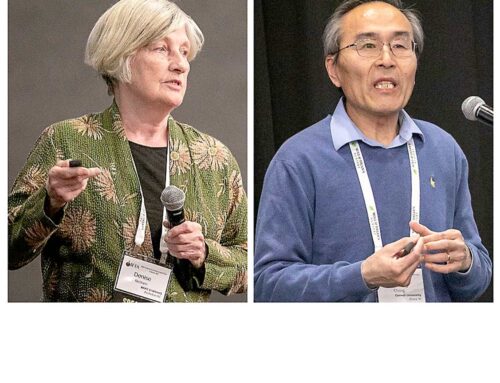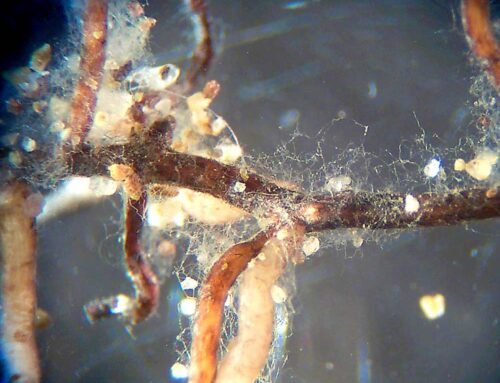
Farmers of all kinds may have a new way to dramatically improve soil quality in low-organic-matter soils. Imagine being able to add organic matter that will last thousands of years, essentially permanently affecting soil tilth and structure, instead of the few years you can get using cover crops and mulches.
The new form of organic material is called biochar. Essentially, it’s charcoal—raw carbon instead of the carbon-hydrogen-nitrogen-oxygen compounds found in the cellulose and lignin of ordinary organic matter in plants and trees.
Biochar doesn’t release nitrogen when it decays, as organic matter does when incorporated into soil, but that can be a good thing.
So far, nobody has tried it in perennial tree fruit systems (except perhaps in hobby orchards). One researcher who’s trying it in vegetable production is Dr. Ajay Nair, a horticulturist at Iowa State University.
“You may want to do some experiments on your own farm.”
—Dr. Ajay Nair
“We’ve found that soil does respond to the addition of biochar,” he said in a telephone interview with Good Fruit Grower. “It makes it lighter and fluffier, decreasing its bulk density and making it less susceptible to compaction.
“It increases waterholding capacity. We think it will increase activity of soil microorganisms, but I haven’t done any work on that yet.”
Nair spoke about his research during the Great Lakes Fruit, Vegetable, and Farm Marketing Expo in Grand Rapids, Michigan, in December.
In only a few years of testing, Nair found that biochar, disk-incorporated into fields, initially reduced yields of crops like sweet corn, carrots, and potatoes, but yields recovered in subsequent years. It appears that biochar absorbs minerals and nitrates and then releases them slowly, he said. “The ability of biochar to hold on to nitrates could adversely affect plant growth, but at the same time, it could reduce groundwater contamination by nitrates,” Nair said.
Although not tested or proven yet, biochar may also provide protection against some soil-borne diseases and plant–feeding nematodes, much as compost does, which could be a yield enhancer on potatoes and carrots.
Moreover, putting carbon in the soil—called sequestration—is now considered a possible way to offset problems associated with global climate change. The soil is a safer sink for carbon than the oceans or the atmosphere, and adding biochar is a way to get it there.
“Carbon dioxide, CO2, is removed from the atmosphere by photosynthesis during the growth of the wood or other biomaterials used to make the biochar,” Nair said. “The carbon remains in the buried biochar when it is added to the soil. Hence, CO2 from the atmosphere is converted to an inert solid that remains in the ground.”
Potentially, farmers can be paid for sequestering carbon. Under the Kyoto Protocol to the United Nations Framework Convention on Climate Change, industrialized countries agree to reduce their carbon emissions. Industries that can do that, like agriculture, can be paid to offset industries that fail to reduce their emissions using other methods such as improving energy efficiency and using renewable energy. Some 37 nations have signed the protocol, but not the United States.
A backstory
As journalists are fond of saying these days, there’s a backstory, and biochar has two of them.
Backstory No. 1 deals with the native peoples of tropical South America. Soil scientists once thought tropical soils could not be economically farmed. Organic matter is too fragile and tropical soil too sterilized by constant heat, rain, and microbial activity. Unless you use slash-and-burn methods to release nutrients, fertility will disappear, it was believed.
About a century ago, however, terra preta was discovered. It seems that native South American Indians had been farming jungle soils of the Amazon productively long before they were invaded and their culture destroyed. They weren’t all about slash and burn. Instead, they apparently burned piles of wood in pits and trenches where oxygen was limited, then used the resulting charcoal as a soil amendment.
In Brazil, it’s now called terra preta do indio—black earth of the Indians. This biochar has a half-life of 1,400 years, Nair said, compared to about six years for organic matter from manure, compost, or cover crops.
A few years ago, Cornell crop and soil scientist Johannes Lehmann studied biochar and its soil-enhancing properties and wrote articles advocating its use to sequester carbon in the soil. It became something of a cult for backyard gardeners. Lehmann estimated that converting residues from commercial forestry and farm crop residues to charcoal could compensate greatly for the fossil-fuel emissions from coal and oil that have nearly doubled carbon dioxide levels in the atmosphere since the Industrial Revolution began about 250 years ago.
So on to backstory No. 2.
In Iowa, where Nair is doing his research, more corn is grown than in any other state. And the corn growers of Iowa are always looking for ways to get more revenue from corn.
If corn stover—cobs and stalks—were gathered after grain harvest and subjected to pyrolysis, two products could be recovered: Biooils and biochar.
Pyrolysis is a process by which organic matter—wood, corn stover—is heated to 350 to 600 degrees with limited oxygen. The heat drives off volatile gases, which can be captured and burned for fuel or liquefied into biooils that can be used for fuel or in place of fossil petroleum to make industrial products such as plastics.
The biochar used in Nair’s experiments was made from hardwood.
Lehmann estimated that cropland could incorporate about 20 tons per acre, and Nair’s experiments have used up to half that amount. Basically, the material was spread on the soil surface and disked in. Worldwide, farmers could use millions of tons of the charcoal pyrolysis could create, in Lehmann’s vision of things.
Because of its long half-life, it’s important that the effects not be negative, because they would be very lasting. Evidence so far is that its effects are positive, Nair said.
Try it at home?
Because there is little research on it, Nair suggests that orchardists and grape growers might want to try it out for themselves on a small scale. “You may want to do some experiments on your own farm,” he said. “Try it out with a few trees or grapevines.” It could easily be made in small quantities for testing, mixing the charcoal into soil in the planting hole.
“Knowing how to apply, how much to apply, and under what circumstances to apply are not widely known or clearly understood,” Nair said.
Not all biochar is the same. It varies in how finely it is ground, and it may be acidic or alkaline, depending on the pyrolysis temperature. Typically, it is alkaline, with a pH of 8 to 9.
Obtaining biochar, however, is not as cheap or easy as it might one day become. Some companies produce biochar for backyard gardeners, many of whom have become enamored by the idea, and it’s expensive, Nair said. •
See www.biochar.org and www.biochar-international.org for more information.






For a complete review of the current science & industry applications of Biochar please see my 2014 Soil Science Society of America Biochar presentation. How thermal conversion technologies can integrate and optimize the recycling of valuable nutrients while providing energy and building soil carbon, I believe it brings together both sides of climate beliefs.
A reconciling of both Gods’ and mans’ controlling hands.
Agricultural Geo – Engineering; Past, Present & Future
Across scientific disciplines carbons are finding new utility to solve our most vexing problems
2014 SSSA Presentation;
Agricultural Geo-Engineering; Past, Present & Future.
https://www.soils.org/files/am/ecosystems/kinght.pdf
Interesting product! Thanks for the story Richard,
Regards,
FreshanaOrganic.com